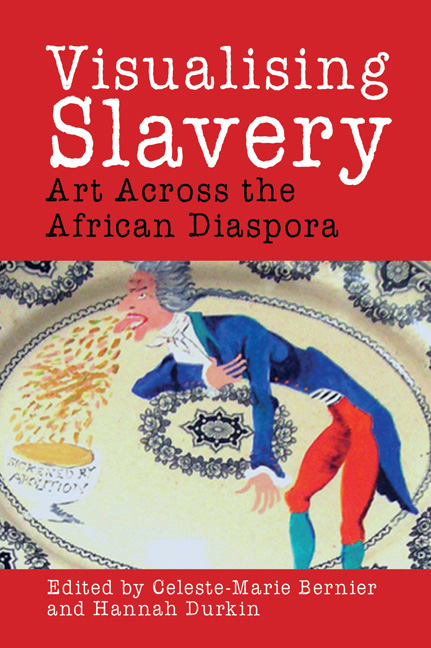Book contents
- Frontmatter
- Dedication
- Contents
- List of Illustrations
- Acknowledgements
- Introduction: ‘Inside the Invisible’: African Diasporic Artists Visualise Transatlantic Slavery
- Part I Slavery and Memory in Contemporary African Diasporic Art
- Part II Historical Iconography and Visualising Transatlantic Slavery
- Chapter 6 The Chattel Record: Visualising the Archive in Diasporan Art
- Chapter 7 Henry Box Brown, African Atlantic Artists and Radical Interventions
- Chapter 8 Uncle Tom and the Problem of ‘Soft’ Resistance to Slavery
- Chapter 9 The After-Image: Frederick Douglass in Visual Culture
- Part III African Diasporic Monuments and Memorialisation
- Part IV Contemporary Legacies in African Diasporic Art
- Afterword: Against the Grain: Contingency and Found Objects
- Notes on Contributors
- Index
- Platesection
Chapter 6 - The Chattel Record: Visualising the Archive in Diasporan Art
from Part II - Historical Iconography and Visualising Transatlantic Slavery
- Frontmatter
- Dedication
- Contents
- List of Illustrations
- Acknowledgements
- Introduction: ‘Inside the Invisible’: African Diasporic Artists Visualise Transatlantic Slavery
- Part I Slavery and Memory in Contemporary African Diasporic Art
- Part II Historical Iconography and Visualising Transatlantic Slavery
- Chapter 6 The Chattel Record: Visualising the Archive in Diasporan Art
- Chapter 7 Henry Box Brown, African Atlantic Artists and Radical Interventions
- Chapter 8 Uncle Tom and the Problem of ‘Soft’ Resistance to Slavery
- Chapter 9 The After-Image: Frederick Douglass in Visual Culture
- Part III African Diasporic Monuments and Memorialisation
- Part IV Contemporary Legacies in African Diasporic Art
- Afterword: Against the Grain: Contingency and Found Objects
- Notes on Contributors
- Index
- Platesection
Summary
African art has two aspects … It has an aesthetic meaning and a cultural significance. What it is as a thing of beauty ranges it with the absolute standards of art … what it is as an expression of African life and thought makes it an equally precious cultural document … the cornerstone of a new and more universal aesthetic … Our museums were full of … this material before we began to realise its art significance. Dumb, dusty trophies of imperialism … assembled from the colonially exploited corners of Africa … Then suddenly there came … a realization that here was an art object intrinsically interesting and fine.
Alain Locke, ‘A Note on African Art’ (1924)The modern artist … was always working with the idea of authorship. The native African sculptor, forgetful of self and fully projected into the idea, was always working in a complete fusion with the art object.
Alain Locke, ‘African Art: Classic Style’ (1935)By some strange neglect, one of the truest, manliest, and bravest of [Virginia's] children,—one who, in after years, will … command the pen of genius to set his merits forth … lives now only in the chattel records of his native State.
Frederick Douglass, The Heroic Slave (1853)The chattel record
In 1853, in the opening frame of his novella The Heroic Slave, Frederick Douglass pointed to the failures of historical consciousness produced by Southern cultures of enslavement. Fusing, as William Andrews shows, fictional and factual discourse in order to generate a platform from which the African American narrative voice could self-authorise, the story of Madison Washington, the heroic slave of the title, also exemplifies that ‘special case in literature’ that is historical fiction: a ‘mode of writing’, José de Piérola argues, that ‘creates and sustains an unresolved tension between history and fiction’. Like the hero of the work – enslaved in Virginia, escaped, recaptured and eventually finding freedom in the British Caribbean following a rebellion led by Washington on board the brigantine Creole in 1841 – the novella operates on ‘the edge of history’, producing a double-edged critique that lays as much emphasis on history as a mechanism of exclusion as on the specific historical distortions and absences that lend the work its thematic force.
- Type
- Chapter
- Information
- Visualising SlaveryArt Across the African Diaspora, pp. 81 - 103Publisher: Liverpool University PressPrint publication year: 2016

